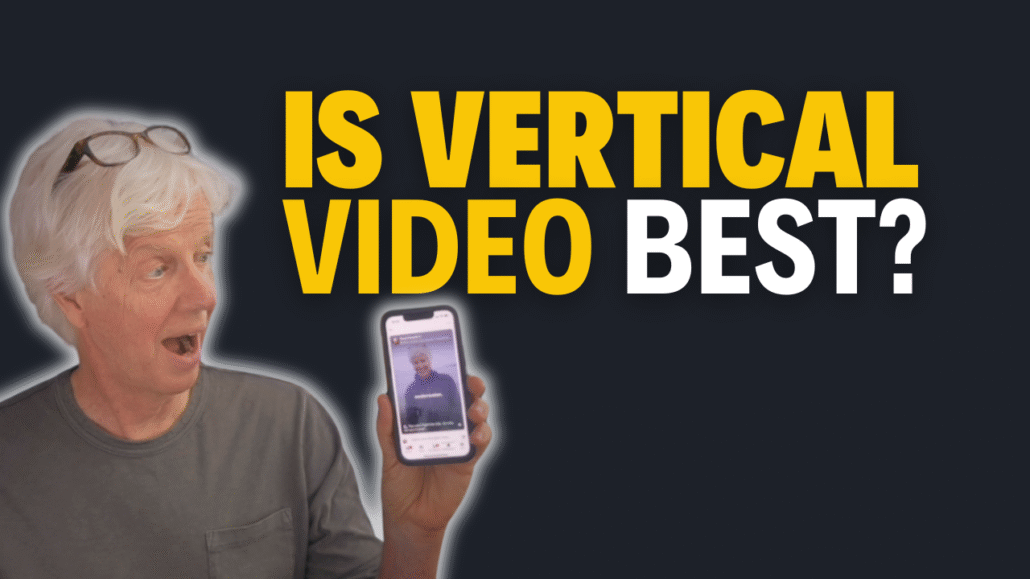
193. Does Vertical Video Really Perform Better on LinkedIn? The Data Says… Nope.
We’ve all heard it:
“Vertical video performs best on mobile.”
“More screen space = more attention.”
“That’s what everyone’s doing on TikTok, so it must work on LinkedIn too… right?”
Well, not so fast.
In this episode of The Standout Business Show, I’m breaking down a $140,000 ad experiment that might completely flip your video strategy on its head.
LinkedIn ad expert AJ Wilcox and video producer Chandler Quintin ran controlled A/B tests across vertical, square, and horizontal video formats — and the results?
Let’s just say vertical isn’t the star of the show.
We’re diving into:
- The surprising format that outperformed all others (yes, even on mobile!)
- Why horizontal video might actually help you stand out as an expert on LinkedIn
- The design psychology and behavior cues that affect content performance
- How to repurpose your most valuable video content for maximum impact
- And why following video trends can sometimes damage your authority
If you’ve been stuck repurposing content in formats that aren’t delivering — or chasing trends that don’t align with how you want to show up — this episode is your permission to do things differently (and smarter).
Resources
🎯 Want help showing up with content that actually builds your authority?
Book a free video brand assessment at micdrop.video — and let’s make your next video unforgettable.
Is Vertical Video Best? Here’s the full episode from The LinkedIn Ads Show podcast with AJ Wilcox & Chandler Quentin
If you’re the best-kept secret in your industry, it’s time to change that.
Because when you start showing up with clarity, confidence, and the right content—your ideal clients won’t just notice you. They’ll choose you.
Don’t miss your chance to get a free video brand assessment to start creating videos that actually work for your business.
Transcript
Brad Powell:
You’ve probably heard it. You might even believe it Vertical video performs best on LinkedIn Because, hey, 80% of LinkedIn’s traffic is on mobile right and vertical takes up more space on the screen, right. It all makes perfect sense until you actually test it. In today’s episode, we’re diving into a $140,000 experiment that puts this assumption to the test once and for all. Vertical versus square versus horizontal, which one performs best? Which one gets watched more, completed more and costs you less to run LinkedIn ad guy AJ Wilcox teamed up with video producer Chandler Quinton to pull the data from some of the video campaigns that they were running together, and what they found might just flip your content strategy upside down.
Brad Powell:
In fact, what if I told you that vertical video was the worst performer? Stick around, because in this episode we’re busting one of the biggest myths in video marketing. Let’s get into it. Myths in video marketing let’s get into it. Welcome to the Standout Business Show. I’m your host, brad Powell, and this is the show for expert business leaders who are making a bigger difference by doing business differently. So here’s the belief that we’ve been sold.
Brad Powell:
Everyone assumes vertical is best because of mobile. So, okay, we live in a mobile first world. A lot of content comes through mobile. Most of the people are watching on a mobile device. If you have a vertical video, it’s going to fill the screen, it’s going to take up more space, which means that, according to this assumption, it’s going to be more attention grabbing and maybe even compel people to stay and watch longer. So it’s got to be better than horizontal, right? I mean, after all, horizontal is smaller and it’s harder to see and it doesn’t grab your attention as much. But as a videographer, I’ve actually always liked horizontal best. I mean, we do live in a widescreen world, but very reluctantly I have changed over to using vertical video once the format spread across social media. I’ve been doing it for my clients and I’ve seen plenty of vertical video perform well on all the different platforms, and so I had settled for the idea that horizontal video use might be over in terms of social media. But this is why I found this experiment so intriguing, because it’s showing that more screen space does not necessarily equal more performance. So here’s what the experiment looked like.
Brad Powell:
So there’s these two guys. One of them is AJ Wilcox and he runs a LinkedIn ad agency and he’s been doing millions of dollars worth of ads on LinkedIn for his clients over the last several years and a video marketing agency owner named Chandler Quinton, and he has a very unique offering in that he doesn’t just make you a video for your ads, he does a whole suite of videos in various formats. And so when a client comes to him and they make video content, what they end up with is a whole set of videos that are in all the different formats vertical, square and horizontal. They were perfectly positioned when they started working together, in that Chandler was making videos for clients and then he was turning them over to AJ and saying here, run these as ads. And so AJ was working on four different accounts and he was spending real money over the four accounts and over the campaigns that they were running. They spent over $140,000. And he did some very controlled A-B testing across the different formats. The same content was being tested in horizontal and in square and in vertical and, much to their surprise, horizontal was the top performer and square was kind of in the middle and vertical was the clear loser. In fact, chandler was saying that horizontal performed four to five times better than vertical video, which, when you take a look at actually spending money on an ad campaign, can, just by changing the format, make your content the same content, perform much better and reach more people and actually get more views, more watch time and more click throughs. You’re actually going to be saving a whole bunch of money. So the takeaway here is that everybody has been following the trend of seeing vertical video do well on TikTok and it’s so immediately saying well, we should do this on YouTube and Twitter and Facebook and LinkedIn. I mean, of course it’s gonna work great on all these other platforms, right? And guess what? It’s not necessarily true. And of course, I wanna say that this matters even if you’re not doing any ads and you’re just doing organic video.
Brad Powell:
Many expert entrepreneurs have been using vertical video because they’ve been told that it works best and it’s especially been good for repurposing you know, from a podcast or repurposing from more long-form video. But here’s my theory about what’s happening on LinkedIn, and that is user behavior plus the way the platform is designed actually still favors horizontal. I think there’s a bit of a YouTube effect, in the sense that a lot of users on LinkedIn are used to watching videos on YouTube and they’re used to a more professional style of presentation, which means that the kind of video that does well on, say, tiktok, which is filled with graphics and jumpy cuts and a lot of sensational imagery. It just doesn’t feel as real and genuine as what people are looking for on the LinkedIn platform. Horizontal feels more like a real presentation, whereas vertical is more social media oriented, it’s more casual and it’s less expert driven.
Brad Powell:
If you want to be seen as the go-to expert, the format that you should choose should match your authority and, of course, you can stand out here by going against the grain, by going against the trend that everyone’s been following. Standing out often means doing what others aren’t doing, like, in this case, using horizontal video. When everyone else is using vertical video Right now, horizontal video could become the bold move on LinkedIn. The thing that I like about horizontal video is that it’s actually easier to produce and or reproduce. So think about when you’re on a Zoom call. Think about when you’re a guest on a podcast. Think about all the client meetings that you have, when you’re expressing your best thoughts and your best insights and you’re telling your stories, and you’re absolutely in that zone of genius where you feel completely comfortable and at ease with the ideas that you have to share and the things that you believe in and what you stand for all of that expression.
Brad Powell:
Well, that material can be captured simply by recording those times when you are in these different kinds of settings and then you can take that in its beautiful horizontal format now and share that as a daily post on LinkedIn. And if you’ve taken the time to set yourself up in your home office studio where you’re well lit and you look good and you have a good microphone and you have a good camera, then people are going to start seeing you in this professional setting, and so being different thoughtfully is what’s going to get you noticed, and not necessarily following the latest trend. And this is exactly why my Mic Drop Moments method is designed the way it is. The videos that we create together are crafted not to go viral but to build trust and authority, and when we’re recording together, we are actually recording in horizontal format, and then I can take that and turn that into multiple different formats. So in this case, they’ll have a horizontal on LinkedIn, horizontal on YouTube and vertical format on platforms like Facebook and Instagram and TikTok.
Brad Powell:
And I’m a firm believer that creating content that works doesn’t require more effort, it just requires a smarter system. So if you’ve been stuck repurposing content in formats that aren’t working for you. So if you’ve been stuck repurposing content in formats that aren’t working for you, or if you’ve been chasing trends that don’t actually align with how you want to show up, then it might be time to rethink your video strategy, which is exactly what we do inside my Mic Drop Moments method. We’ll create high-authority content and in just one hour a month, you can show up powerfully with video that works for you. So if you want help making that shift, head to micdropvideo to book a free video brand assessment and let’s make your next video unforgettable unforgettable.
Brad Powell:
And that’s it for today’s episode of the Standout Business Show. Thanks for listening. If you found this episode helpful, don’t forget to subscribe and share it with a friend, because the number one way that people find out about a podcast like this one is because they heard about it from one of their friends. Remember, keep making a bigger difference by doing business differently.


